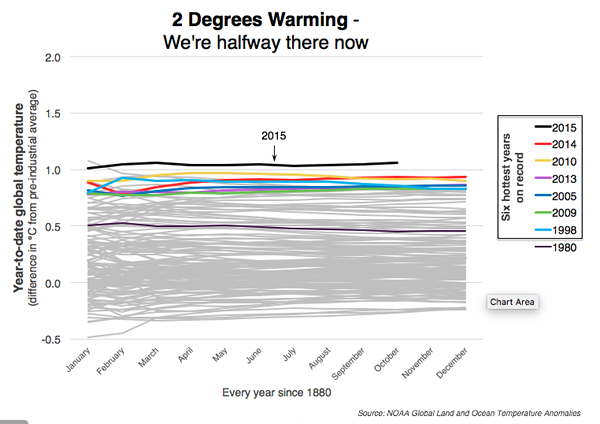The big news from Paris overnight was Canada throwing its weight behind a bid to limit warming to 1.5 degrees. While it is an eye-catching political move from a new administration, the reality of the situation facing the world is quite different.
It’s naïve to think that even the current agreement to limit global warming to two degrees can be achieved considering the lack of political action. We could be at the point it’s inevitable in just 15 years. The following is the observational evidence.
The first graph illustrates where global temperatures have been and where they’re up to.

Clearly most of the 1.02 degrees of global warming since pre industrial times has occurred since 1980 – in fact 0.56 degrees of it. If nothing else this is a good demonstration of the slow (some might say fast) moving train wreck that greenhouse gas emissions are. The second graph shows the rate of increase of atmospheric concentration of CO2.

This graph tells us not just that the concentration is rising, but that the rate of increase in that concentration is rising (i.e. the increase in concentration each year is on a rising trend). That is at least partly due to our per annum emissions getting larger, but may also be because the ability of the oceans to remove some of that carbon from the atmosphere is slowing. It doesn’t matter really, it is full steam ahead as far as the driver of global temperature is concerned.
In other words, to keep warming to two degrees, greenhouse gas emissions need to plateau very soon and then decline. At the moment they are still rising, and at an increasing rate.
If annual emissions remain at their current rate it will only take another 30 years for the carbon in the atmosphere to be at a level concomitant with 2 degrees of warming. If we halved the emissions tonight, it would take only 60 years. Have a look at the track of our emissions in the next graph and you can see that there is precious little evidence that global emissions are falling. Ironically, after years of being the pariah, the most hopeful signs are emerging from China.

This graph doesn’t include emissions contributions from land clearing and other greenhouse gases. The full dataset isn’t as up-to-date but you can see from the next graph taken from the 2014 IPCC report what the track of all emissions had been to 2010.

It has taken time for politicians to first abandon their denialist prejudice and then to accept the 2 degrees milestone (2009 Copenhagen Communique). Since then, their rate of catch-up with reality is still miles from what’s needed. Just take our own government – it offers an 11% cut in emissions by 2030 compared to the public’s submissions that demanded 40%, it exaggerates the costs of getting emissions down, and then it tries to cover up the fact it hasn’t reduced emissions one iota by bullshitting about the comparative costs of getting emissions down here compared to in other countries.
Why such blatant dishonesty? The only reason I can unearth is they simply don’t think politically they’ll survive if New Zealand starts playing catch up with where most developed countries have gone since 1990 – reduced their domestic per capita emissions. Either that or we really are governed by a bunch of Tony Abbott-style denialists who try to deny they’re deniers via misleading hyperbole about the difficulties of providing leadership on this issue.
Anyway the reality is if the current lame response from governments continues, 2 degrees will be all but locked in by 2030. This is why the world’s wealthiest philanthropists are getting together to seriously fund technological advances to try and head off such a scenario. It is clear the politicians simply aren’t up to the task, fearing for their own careers instead, so they need to be pushed aside by someone with the wherewithal to effect mitigation technologies.
And of course our own PM is so happy about this he is already making smug claims that these technological breakthroughs will save his government from having to do anything, that we can prevaricate and commit to highly conditional and puny reduction targets because in the end technology will save us doing any more.
That’s a highly speculative and of course irresponsible approach with geopolitical risks for New Zealand’s reputation as well, but by then he will have been well retired, and like Muldoon, his negligence no longer relevant. Such is the toxicity of short-term political players.
Two degrees of course is not a bright line. All the scientists can indicate is that with such a temperature rise the risks of catastrophic weather events rise in a highly unpredictable way. Whether destabilising feedbacks are set in train is a topic of hot debate, but every serious climate scientist sees two degrees as humankind entering the world of the unknown.
The task at hand is to eliminate all additions to the atmospheric carbon concentration and then start withdrawing carbon from the atmosphere. It is so far away from where the politicians are talking that for business it would be madness to invest on the basis that more than two degrees is not imminent.
Such is the difference between the fantasy world politicians play in and the reality that investors have to deal with.

